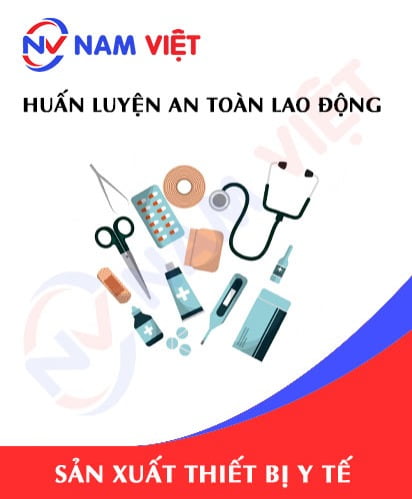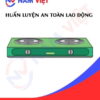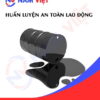Occupational Safety Training for Medical Device Manufacturing
99,000 ₫
Note: The price above is calculated per person. Prices may vary depending on the number of trainees participating in the course and market fluctuations. For more accurate pricing support, please refer to the quotation or contact our consultant directly.
Occupational safety is an important issue in medical device manufacturing factories and needs to be addressed promptly to ensure the health and safety of workers, and enhance the reputation of businesses. The occupational safety training course is one of the effective solutions to raise awareness on how to prevent workplace accidents for workers involved in medical device manufacturing.
Table of Contents
Toggle1. Overview of Medical Devices
a. What are medical devices?
- Medical devices are devices designed for use in medical applications, including diagnosis, treatment, and health monitoring. Medical devices can be used in medical facilities such as hospitals, clinics, and community health centers or used at the patient’s home.
- The medical device manufacturing industry in Vietnam has been developing positively in recent years. According to the Ministry of Health of Vietnam, in 2020, domestic medical device manufacturing met 50% of the domestic demand and was exported to the international market.
- Vietnamese businesses have proactively invested in researching and developing new medical device products, which helps improve quality and competitiveness in the market. Many companies have obtained quality certifications and certificates, which helps increase the competitiveness of their products in the international market.
- The Vietnamese government is also promoting support for businesses in the medical device manufacturing industry. The promotion of the development of the medical industry is included in the Nationalization and Industrial Development Program.
- However, the medical device manufacturing industry in Vietnam still faces many challenges, including fierce competition from imported products, high investment costs for product research and development, and difficulties in dealing with product certification and inspection procedures.

b. Types of medical device manufacturing machinery
The types of medical device manufacturing machinery are divided into many different categories depending on the nature and characteristics of the product. The following are some of the main types of machinery used in medical device manufacturing:
- Sterile injection machine: A sterile injection machine is used to manufacture sterile injection materials, including needles, nozzles, and injection parts.
- Molding machine: A molding machine is used to produce plastic or metal parts, including special materials to produce medical products.
- Packaging machine: A packaging machine is used to package medical products, including protective packaging, automatic packaging, and semi-automatic packaging.
- Testing machine: A testing machine is used to test the features and accuracy of medical products, including diagnostic testing devices and quality inspection devices.
- Laser machine: A laser machine is used to produce special medical products, including decorative products, guide tubes, and other parts.
- Cutting machine: A cutting machine is used to cut medical products, including metal and plastic products.
These types of machinery are all designed to meet the special requirements of medical device manufacturing and comply with high safety and quality standards in the medical industry.

c. Typical medical device manufacturing enterprises
There are many typical medical device manufacturing enterprises in Vietnam; here are some examples:
- Viet A Corporation: Viet A is one of the leading enterprises in the field of manufacturing and trading pharmaceutical products and medical supplies in Vietnam.
- DHG Pharmaceutical JSC: DHG is a leading enterprise in the manufacturing and trading of pharmaceuticals, medical products, functional foods, and medical supplies in Vietnam.
- Vietmedical: Vietmedical is an enterprise specializing in the manufacturing and distribution of medical products such as bandages, adhesive tapes, cotton, sterile products, and other medical products.
- Vinamed: Vinamed is a medical device manufacturing enterprise that produces testing machines, ultrasound machines, blood pressure monitors, blood glucose meters, health care products, and other consumer products.
- Medical Devices JSC: Medical Devices JSC is a medical product manufacturing enterprise that produces hospital bed frames, medical cabinets, pharmaceutical cabinets, sample preservation cabinets, and other medical products.
In addition to the above enterprises, there are many other medical device manufacturing enterprises such as VietLife, QMed, Vigor Medical, Pharmedic, DKSH, and the B.Braun group.
d. Specific jobs in a medical device manufacturing factory
Group 1
- Executive director, deputy executive director, department head in a medical device manufacturing factory.
Group 2
- Safety officer: manages safety in the factory, designs safety procedures, monitors and urges employees to comply with safe working procedures.
Group 3
- Manufacturing technician: Manufacturing technicians work directly on production lines and equipment to manufacture medical products, including testing, inspecting, and adjusting production equipment.
- Quality employee: The quality employee ensures that the medical products manufactured meet the necessary quality and safety standards.
- Inspector: The inspector performs tests to ensure that the medical products meet the customer’s requirements.
- Packaging employee: The packaging employee is responsible for packaging medical products to ensure the safety and quality of the product during transportation and use.
- Maintenance employee: The maintenance employee performs maintenance, repair, and upkeep of production equipment to ensure that it operates properly and effectively.
- Warehouse management employee: The warehouse management employee ensures that medical supplies and products are stored and managed properly to meet production needs.
Group 4
- Office, service, sales, and marketing jobs.
- Quality management, human resources management, material management, and financial accounting management.
- Production management: The production manager works with manufacturing technicians to manage the production process and ensure the efficient operation of the factory.
- Design technician: The design technician is responsible for designing and developing new medical products, including medical devices, machinery, and materials.

e. Common types of medical equipment
Here are some common types of medical equipment used in the medical industry:
- Radiation therapy machine: Radiation therapy machines are used to treat cancer and other pathologies by using radiation rays.
- Blood pressure monitor: A blood pressure monitor is used to measure a patient’s blood pressure. It can be used at home or in medical facilities.
- Blood glucose meter: A blood glucose meter is used to measure the concentration of sugar in a patient’s blood, especially for those with diabetes.
- Ultrasound machine: An ultrasound machine is used to diagnose and monitor pathologies in the body by using ultrasonic waves.
- Ventilator: A ventilator is used to support a patient’s respiration when they cannot breathe independently.
- Pacemaker: A pacemaker is used to assist and improve heart function for patients with heart problems.
- Computed tomography scanner (CT scanner): A CT scanner is used to take 3D images of organs and tissues in the body by using X-rays.
- Magnetic resonance imaging (MRI) machine: An MRI machine is used to take 3D images of organs and tissues in the body by using a magnetic field.
- Vaporizer: A vaporizer is used to treat respiratory problems and provide relaxing and healthy benefits.
- Health sensor: A health sensor is used to monitor a user’s health by measuring indicators such as heart rate, body temperature, activity, and sleep.
- Syringe needle: This tool is used to inject medicine into the body intravenously, intramuscularly, or subcutaneously.
- Oxygen cylinder: This tool is used to provide oxygen to patients in cases of poor respiration or lack of oxygen.
- ENT examination light: This tool is used to examine a patient’s ears, nose, and throat.
- Surgical table: This tool is used in surgeries to hold and support the patient during the surgical process.
2. Overview of the labor safety training course for medical device manufacturing
Within the scope of this article, we will focus on issues related to group 3, because group 3 is the group directly involved in the manufacturing process and bears the highest risk of labor safety. See more about the other groups here
a. What is group 3 labor safety training?
- Labor safety training for group 3 consists of sessions that provide awareness of how to prevent labor accidents for workers.
- The labor safety training course will help workers recognize and avoid dangers and limit the risks of labor accidents during work.
b. Training time
First-time safety training time
- The total training time is at least 24 hours, including the test time.
- 8 hours of theoretical study on the system of policies and laws on occupational safety and health.
- 8 hours of theoretical study on basic knowledge of occupational safety and health.
- 4 hours of theoretical study on specialized training content.
- 2 hours of practical training on specialized training content.
- 2 hours for a theoretical test at the end of the training course.
The safety training center will distribute the time into many training sessions depending on the time arrangement for employees. But usually, there will be 6 training sessions, and the course will take place over 3 days, provided that the manufacturing company can arrange continuous study time.
Periodic safety training time
- Before the labor safety card expires, if workers want to renew it, they must undergo a periodic labor safety training course, with the periodic safety training time being at least 50% of the first-time safety training time.
Explanation: The total periodic labor safety training time is at least 12 hours, including the test time. After completing the periodic training course and passing the test, the worker will be re-issued or have their labor safety card renewed.
c. Contents of the training course
| No. | TRAINING CONTENT | TRAINING TIME (HOURS) | |||
| Total | Of which | ||||
| Theory | Practice | Test | |||
| I | System of policies and laws on occupational safety and health | 8 | 8 | 0 | 0 |
| 1 | Overview of the system of legal documents on occupational safety and health. | 6 | 6 | ||
| 2 | System of technical standards and regulations on occupational safety and health. | 1 | 1 | ||
| 3 | Specific regulations of state management agencies on occupational safety and health when building new, expanding, or renovating works, facilities for manufacturing, using, preserving, storing, and inspecting machinery, equipment, materials, and substances with strict requirements on occupational safety and health. | 1 | 1 | ||
| II | Basic knowledge of occupational safety and health | 8 | 8 | 0 | 0 |
| 1 | Basic knowledge of hazardous and harmful factors in the workplace. | 4 | 4 | ||
| 2 | Methods for improving working conditions. | 1 | 1 | ||
| 3 | Safety culture in manufacturing and business. | 1 | 1 | ||
| 4 | Rights and obligations of the employer, employee; policies, regulations on occupational safety and health for employees; functions, duties of the occupational safety and health network. | 1 | 1 | ||
| 5 | Occupational safety and health regulations, signs, safety and health guides, and the use of safety equipment, personal protective equipment; skills and techniques for first aid for labor accidents, and prevention of occupational diseases. | 1 | 1 | ||
| III | Specialized training content | 6 | 4 | 2 | 0 |
| General knowledge about types of machines, equipment, and substances that generate hazardous and harmful factors; analysis, evaluation, and management of occupational safety and health risks, safe working procedures with machines, equipment, and substances with strict requirements on occupational safety and health. | 6 | 4 | 2 | ||
| IV | Safety training test at the end of the course | 2 | 2 | 0 | 0 |
| Total | 24 | 22 | 2 | ||
See more training content for 6 groups
d. Labor safety card
After completing the labor safety training course and passing the test, the worker will be issued a labor safety card (in practice, it is often called the group 3 labor safety certificate).
The group 3 safety card will clearly show information such as: full name, date of birth, specific job, and working environment. It also has the training time, red stamp, and signature confirming completion of the training course.
According to the regulations on issuing safety cards as specified in Clause 2 Article 24 of Decree 44/2016/ND-CP, there are 2 cases:
- If the employer and the employee have a labor contract with each other, the employer must sign, stamp, and initial the safety card for the trained person in group 3 after they have gone through the training course from a labor safety training unit and passed the test.
- If the worker is a freelancer, seasonal worker, and does not have a labor contract, the training unit must sign, stamp, and initial the safety card for the worker after they have gone through the training course from a labor safety training unit and passed the test.

3. Identifying hazards in medical device manufacturing
Medical device manufacturing is a very important field that requires safety and quality assurance. When manufacturing medical devices, it is necessary to identify and deal with potential hazards that can cause serious consequences. The following are some typical hazards when manufacturing medical devices:
- Materials used in medical device manufacturing can pose a risk if quality is not properly guaranteed. For example, using non-standard materials can cause harm to the health of the user.
- Medical device manufacturing equipment can pose a risk if it is not used or maintained correctly. For example, using damaged equipment can cause labor accidents or products that do not meet quality standards.
- The manufacturing process can pose a risk if it is not performed correctly or if it does not meet quality and safety requirements. For example, manufacturing medical devices that are not up to standard can lead to products that are not of good quality or are not safe.
- Medical device manufacturing can pose an environmental risk if the proper waste treatment process is not carried out and products containing toxic substances are not managed correctly.
4. Common labor accidents in medical device manufacturing
The job of manufacturing medical devices often requires focus and caution, and it can cause labor accidents. Common labor accidents that occur when manufacturing medical devices include:
- Being cut or stabbed by sharp materials, cutting knives, and other cutting tools during production.
- Being crushed or hit by medical device manufacturing machinery or heavy materials.
- Being burned or exposed to UV or X-ray radiation from manufacturing machines.
- Occupational diseases from exposure to chemicals during manufacturing, such as heavy metals, solvents, and detergents.
5. Safety measures when participating in medical device manufacturing
Ensuring safety in medical device manufacturing is very important to ensure product quality and protect the health of workers. The following are some safety measures that need to be implemented when participating in medical device manufacturing:
- Ensure full personal protective equipment such as masks, safety glasses, aprons, gloves, protective shoes, etc.
- Ensure the workspace is spacious, airy, and clean.
- Ensure that manufacturing equipment, machinery, tools, and materials all meet safety requirements, are inspected, evaluated, and maintained periodically.
- Strengthen supervision, labor safety training, and periodic inspections to ensure that workers are working according to procedures and safety standards.
- Implement fire prevention and fighting measures, check the electrical system, compressed air pressure, etc., to ensure fire and explosion safety.
- Implement legal regulations on occupational safety and health.
- Ensure environmental protection and minimize negative impacts on the environment.
- Implement infection prevention measures, ensure personal hygiene, and comply with food safety and hygiene regulations.
- Implement data protection measures and manufacturing information security protocols to ensure product information safety and security.
- Periodically organize labor environment monitoring in the factory or enterprise, collect and analyze harmful factors to workers, thereby adjusting the level of harm to prevent occupational diseases for them.

6. Benefits of labor safety training for medical device manufacturing
An Toan Nam Viet provides businesses with the following great benefits after completing labor safety training courses as regulated in Decree 44/2016/ND – CP on occupational safety and health for companies, factories, and enterprises.
- Workers can identify the potential risks of labor accidents and take preventive measures to avoid labor accidents.
- Your business can establish risk prevention measures in the production, operation, and maintenance process.
- Minimize costs when unsafe conditions occur in labor.
- Uninterrupted production will help increase labor productivity and product quality.
- Comply with labor safety laws, avoiding legal risks.
- Create prestige and professionalism in all aspects, thereby enhancing your business’s brand.
Nam Viet’s training courses are a solution to prevent and combat external factors affecting each individual so that they can avoid danger that can lead to injury or, more seriously, death.
7. Customer feedback after completing the labor safety training course for medical device manufacturing
An Toan Nam Viet has many years of experience in accompanying many businesses in Vietnam in general and in the southern provinces in particular. And that responsibility is something extremely valuable to Nam Viet, which is why Nam Viet’s Labor Safety Training work is increasingly focused on becoming more professional. The motivation for An Toan Nam Viet to grow strongly comes from the positive feedback and suggestions from businesses. Below is the feedback from the partners we have served.
Bac Nam E&C Investment and Construction Joint Stock Company
“The first time I used the service at An Toan Nam Viet, I was very surprised by the enthusiastic 24/7 support from the team of consultants. The class organization was very quick and convenient for our company, thank you very much for Nam Viet’s service!”
Hoa Dat Construction and Trading Joint Stock Company
“Nam Viet’s service has helped us a lot in simplifying labor safety and the process of completing safety records for our work. The team of consultants is enthusiastic and responds promptly to our questions. 5 stars for Nam Viet”
See more other feedback from customers of An Toan Nam Viet
8. Labor Safety Training Competence of An Toan Nam Viet
An Toan Nam Viet is currently a reputable and high-quality center specializing in labor safety training in Vietnam. With labor safety training sessions taking place continuously at manufacturing workshops, factories or construction sites across the country (63 provinces and cities in Vietnam).
Labor safety training license
- An Toan Nam Viet has been inspected and certified by the Department of Labor Safety of the Ministry of Labor – Invalids and Social Affairs as a unit qualified to conduct occupational safety and health training activities. This further solidifies our capacity to conduct labor safety training.

Materials and lectures
- Before the labor safety training materials are included in the labor safety training courses, they are reviewed and approved to ensure that the lectures are accurate in terms of knowledge and effective when applied.
- The teaching method of our lecturers is synchronized according to the teaching standard of An Toan Nam Viet, which is a method that experts in occupational safety and health training have researched and refined during the teaching process to bring the highest knowledge acquisition efficiency to students.
Facilities
- Controlling the factors in the classroom that affect the training process will increase teaching performance and the effectiveness of knowledge acquisition for students.
- Our facilities supporting the training course always have spacious classrooms that meet standards for area, lighting, training equipment, etc.
9. Reputable and High-Quality National Safety Training Center
At An Toan Nam Viet, we always place our professional dedication to labor safety training as a top priority. For us, imparting the knowledge of self-protection to workers so they have a safe foundation on their journey to make a living is a way of contributing to national development.
To ensure effective training, we prepare carefully and meticulously for every little detail, no matter how small. From preparing tools, equipment, and teaching devices to curriculum, materials, sound, and lighting.
Our labor safety training instructors are experts with many years of experience in the field. They even have research projects on identifying risks in all professions and how to prevent them.
The lecturers’ presentations are distilled from practical experience and are conveyed in the most vivid and easy-to-understand way for workers. These factors help workers feel comfortable during their studies and effectively absorb our taught knowledge. Of course, the knowledge conveyed is always in line with Decree 44/2016/ND-CP.
This allows workers to grasp many measures to prevent dangers and how to protect themselves. At the same time, they can apply this knowledge in the most appropriate way in their actual work.
Our safety training center is proud to be a reputable and professional provider of labor safety training services with the following advantages:
- Competitive training costs, while training quality is still guaranteed.
- Flexible training schedules that adapt to the production situation of the company.
- Fast procedures for issuing labor safety training certificates in compliance with legal regulations.
- Training instructors are people with many years of experience in the profession.
- Classrooms are controlled for factors affecting the training process, increasing teaching performance and the effectiveness of knowledge acquisition for students.
- Lectures are compiled to be suitable for labor safety work at businesses.
- An Toan Nam Viet works with dedication and professionalism to support customers accurately and quickly.

10. For more reference materials on labor safety training for medical device manufacturing
- Labor safety materials for medical device manufacturing
- Labor safety training materials
- Labor safety training test questions
- Multiple-choice test for labor safety in medical device manufacturing
- Slides of the lecture on labor safety training for medical device manufacturing
1 review for Occupational Safety Training for Medical Device Manufacturing
No comments yet















namchinh.haiphong341
Dịch vụ huấn luyện an toàn lao động rất tốt nhé, giảng viên dạy rất sinh động dễ hiểu!